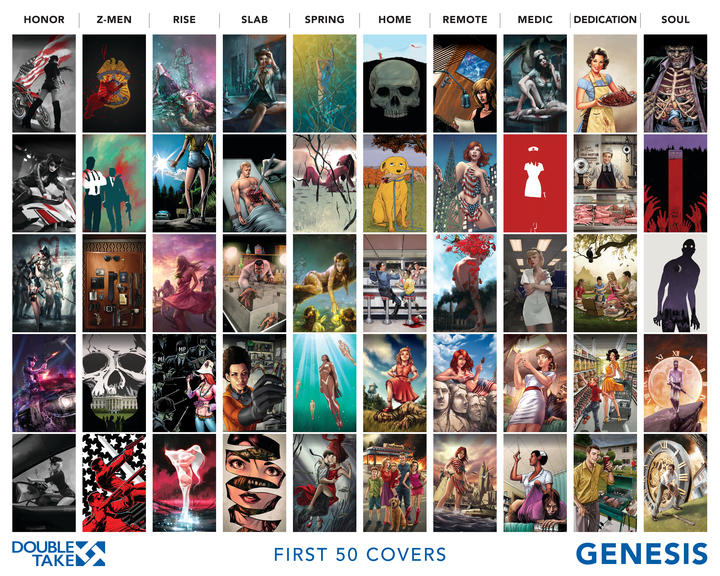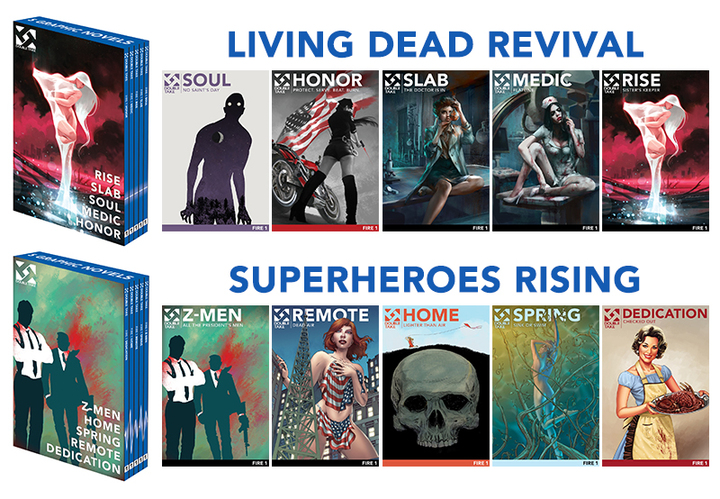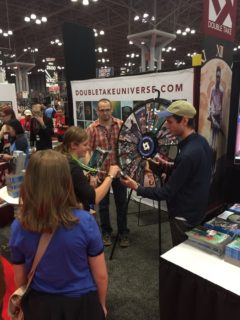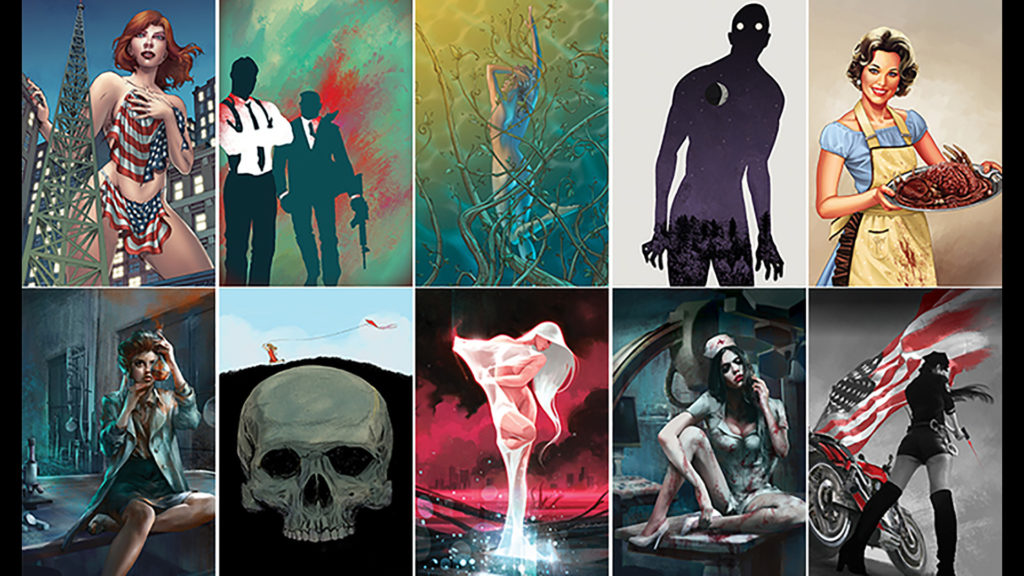Double Take Comics, owned by Grand Theft Auto publisher Take-Two Interactive, is out to add a new twist to age-old zombie stories. The comic book publisher made the ambitious move of launching ten books simultaneously last year, all based in the same world inspired by the 1968 George Romero movie Night of the Living Dead.
The comic book publisher is looking to further shake up the comic book industry by developing its books with an emphasis on digital reading on mobile devices before bringing them to printed pages—in that every panel is animated with each tap or click. The first few issues of each comic can be read for free on Double Take’s official website.
Bill Jemas, general manager at Double Take (and former VP at Marvel Comics) and story editor, Mike Coast talk to [a]listdaily about Take-Two’s interest in the comic book industry. The two also discuss the challenges of breaking out as an increasing number of comics books are adapted for movies and television, along with the unstoppable power of zombies.
How did the idea to create Double Take Comics come together?
[Jemas]: I wanted to get back into creative development work, and Take-Two wanted to start a comic book division. So in 2013, Take-Two hired me to start Double Take. Our story editor, Mike Coast, was our first employee. We spent a year making mistakes, if you will: trying things and developing things that Mike and I didn’t think were good enough to see the light of day. It’s not unlike what we did at Marvel—throwing 5,000 characters against the wall and Spider-Man stuck.
Take-Two Interactive is mainly known as a video game publisher and developer. What is its interest in comic books?
[Jemas]: Comics are an excellent way to conduct R&D on new creative—especially with our method of storytelling. We have excellent in-house storyboard artists, Stan Chou and Jon Ashley, who can turn a rough concept into a visual story in a day. So, it’s very easy for us to test what works and doesn’t work, which in turn, fosters wide-open creativity.
Why isn’t Double Take publishing comics based on popular Take-Two properties such as Grand Theft Auto, Borderlands, BioShock or Red Dead Redemption?
[Jemas]: All of those games are wonderful and wildly successful in their own right, and the Double Take team would love to work on them, but Take-Two wants to expand its portfolio of entertainment properties.
Double Take’s stated goal is to be different and change the status quo. What distinguishes its comics from others, including Marvel, DC Comics and Skybound Entertainment?
[Coast]: One of the ways that we’re different is that we’re actively trying to reach people who don’t normally read comic books. Maybe they’re fans of comic book movies, maybe they’re science fiction fans, or maybe they’re not normally into geek culture at all. So, we wanted to have a very low barrier for entry—affordable comic books, first issues that weren’t loaded with backstory, and dialogue that is interesting, informative and funny. One of the other ways that we’re different is that we’ve focused on digital from the very beginning. Our production process builds panel-by-panel rather than page-by-page.
What led to basing the Double Take universe on Night of the Living Dead?
[Jemas]: After a year of trying new ideas that didn’t stick, Mike had an idea that we start stories set in the universe established by Night of the Living Dead. He knew the film was in the public domain and it had a decent cult following. So, we had a blast; we let our imaginations and our zombies run wild for the first few months, and over a year, refined that into the stories you see today.
How do you keep zombies, based on one of the most well-known zombie movies in history, fresh and original?
[Coast]: I think that’s a two-part answer. The first part is that we don’t focus on the zombie aspects all that much. Almost all of these books focus on central characters with lives and goals that center on things other than zombies. Yes, there are zombies, and it’s a big part of some of the stories. But we didn’t want this to feel like the only goal of each comic was “survive the zombies.” Not to completely spoil everything, but there are politics, super powers, aliens and all sorts of other things happening in the pages of these issues; not just zombies.
The second part is that we did something different with the zombies. They’ve come back from the dead, sure. But that doesn’t mean that they’re brainless, witless or speechless. Most of them start out that way. But we’re treating them in many cases as real, rounded characters who can learn and grow over the course of a story arc.

Launching ten books simultaneously sounds like quite an undertaking. What convinced Double Take to use this approach?
[Jemas]: It was a trip to Midtown Comics. We saw the shelves stocked full with thousands of comics. We realized then that releasing one or even three titles would be a drop in the ocean. So, we decided to release all ten in one big bang.
How do you make readers aware of ten simultaneous, connected books?
[Coast]: We tried to make it so that a reader could read just one series and have a full experience. We didn’t want to require readers to have to buy ten comics at once to understand a given story. At the same time, we wanted each series to have connections to other titles so that the more someone reads, the richer the experience would be. One way that we drove awareness of the crossover was packaging the individual issues in Super Packs—that is, all ten first issues, all ten second issues, etc. Similarly, we packaged the graphic novels into two Binge Boxes, each containing five graphic novels.

Is it challenging to create comic books that present well in both physical and digital formats?
[Coast]: We were lucky in that we realized early on that it was easier to build for digital and then convert to print than it was to build for print and then convert to digital. We found that in panel-by-panel, we were able to create a digital storyboard that animated as a reader flipped through. This provides a unique reading experience on desktop as well as, more importantly, mobile. Our comics read better on cell phones than any other experience I’ve had. So, while it’s challenging training traditional comic writers and artists (as well as ourselves) to think in terms of panel-by-panel rather than page-by-page, we think that it’s worth the effort.
 How do you handle discoverability, both through digital comics and physical?
How do you handle discoverability, both through digital comics and physical?
[Jemas]: Since issue one, we’ve been offering our content to readers for free. Our first issue was made available for free on ComiXology and on our website. New readers can still read issues 1-3 of all ten series for free on doubletakeuniverse.com.
Most recently, we gave away 15,000 graphic novels at NYCC (New York Comic Con) as prizes. Con-goers could spin the wheel, play blackjack, or draw a random card to win a book. If people like the content, they’ll come back for more—and they certainly did at NYCC.
Are you seeing a strong move to digital comics instead of physical comics?
[Jemas]: I don’t think the comic industry is taking advantage of the potential online audience. Outside of traditional readership, the industry hasn’t tapped into digital books in any meaningful way. I think one reason is because the digital books are overpriced. Another is because the tools—like Guided View on ComiXology and the PDF scroll on MadeFire—aren’t good ways to read graphic fiction. As Mike’s described already, we spent a lot of time developing our storyboard format to optimize our stories for digital reading: you can read panel-by-panel on your phone clearly.
With so many zombie-themed comics, books, TV shows and movies out now, what do you think is the enduring attraction of the undead?
[Coast]: For creators, they make for an easy enemy most of the time. It’s sort of a shortcut. Almost like a natural disaster. They’re something that has to be survived. That seems to be the case most of the time. Some zombie stories are more nuanced than that—we like to think ours are. And, of course, zombies provide plenty of opportunities for violence and gore. From an audience perspective, it’s a glimpse into a world where there are no rules, which could be fun, or terrifying, or a mix of both. I don’t think many people would want to live in the world of a zombie story, but it can be fun to visit for a few hours at a time.

